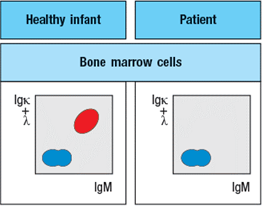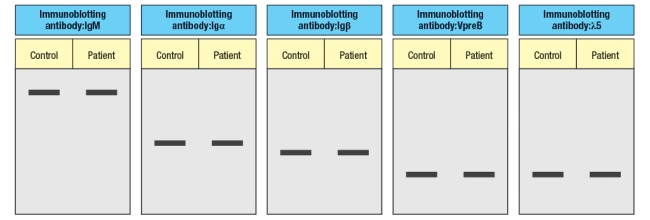An infant is admitted to the hospital with a history of recurrent and persistent bacterial infections. His physician suspects he has an immunodeficiency disease, and obtains a sample of the patient's peripheral blood. The white blood cells are analyzed by antibody staining followed by flow cytometry, and the results are shown in Figure. 
To determine the origin of the peripheral blood cell defect, a bone marrow biopsy is taken from the patient and compared to a healthy control, as shown in Figure.

To obtain additional information, bone marrow cells are treated with a chemical that permeabilizes the cell membrane, allowing antibodies to enter the cells and bind to their target antigens within the cells, a technique known as ‘intracellular staining’. The results of this analysis are shown in Figure .
a) What are populations 1, 2, and 3 in Figure?
b) In the analysis of cell surface expression (non-permeabilized bone marrow cells), what are the IgMlo Igκ+λneg cells as indicated by the arrow in Figure? 
c) What is the most likely defect causing the patient's immunodeficiency?
The results shown above indicate a specific defect in B cell development. To help identify the defective or missing protein in the patient's developing B cells, bone marrow cells are isolated and protein lysates are prepared for immunoblotting. A series of antibodies are tested and the results are shown in Figure.

d) Given the results from the immunoblotting experiments, what is the most likely candidate molecule (or type of molecule) responsible for the patient's immunodeficiency disease?
Correct Answer:
Verified
View Answer
Unlock this answer now
Get Access to more Verified Answers free of charge
Q24: The repertoire of T-cell receptors, like that
Q25: Experimental mouse models have been developed
Q26: Synthesis question: To investigate how T-cell
Q27: If one swapped the regulatory elements
Q28: The final stages of T cell
Q30: MHC class II molecules expressed on
Q31: Current evidence indicates that >95% of
Q32: Like the
Q33: Two mutant lines of mice have been
Q34: Approximately one in every three
Unlock this Answer For Free Now!
View this answer and more for free by performing one of the following actions

Scan the QR code to install the App and get 2 free unlocks

Unlock quizzes for free by uploading documents